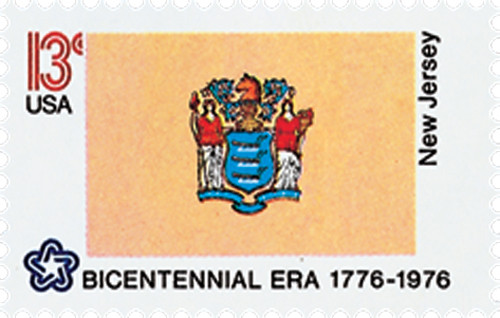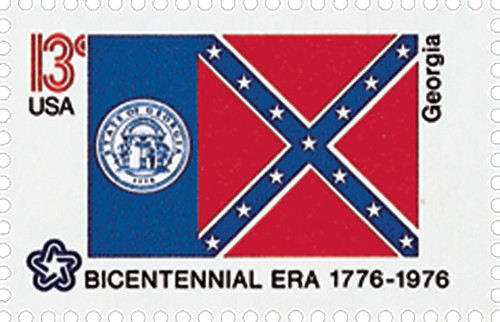
# 1652 - 1976 13c State Flags: Mississippi
U.S. 1652
1976 Mississippi
State Flags
American Bicentennial Series
• First time a sheet 50 had all different stamp designs
• Part of the American Bicentennial Series
Stamp Category: Commemorative
Series: American Bicentennial Series
Value: 13¢ First-class postage rate
First Day of Issue: February 23, 1976
First Day City(s): Washington, DC
Quantity Issued: 8,720,100 (panes of 50)
Printed by: Bureau of Engraving and Printing
Printing Method: Photogravure
Format: Sheet of 50
Perforations: 11
Why the stamp was issued:
The United States Postal Service celebrated the American Bicentennial with a full pane of the Union’s fifty state flags.
About the stamp design:
In 1894, the current state flag was approved by the Mississippi State Legislature. Reflecting Mississippi’s Southern heritage, the flag included the Confederate Cross as the canton (upper left corner). The rest of the flag is striped – blue at the top, white in the middle, and red at the bottom.
In 2020, a new flag was ratified. The flag is still striped with stripes going vertically, two large red strips on each side, followed by two thin gold stripes and one large blue stripe down the middle. In the middle of the blue stripe is 20 white stars representing the first 20 states including Mississippi and a gold star at the top representing the five indigenous Native American tribes of Mississippi. On the bottom of the circle of stars states “In God we trust.” In the middle of the circle is a magnolia flower symbolizing hospitality.
About the printing process:
Printed by the Bureau of Engraving and Printing on their seven-color Andreotti gravure press (601) which was their work horse for multicolored stamps.
About the American Bicentennial Series:
In the 1970s, America celebrated its 200th anniversary with hundreds of national events commemorating the heroes and historic events that led to our nation’s independence from Great Britain. The U.S. Postal Service issued 113 commemorative stamps over a six-year period in honor of the U.S. bicentennial, beginning with the American Revolution Bicentennial Commission Emblem stamp (U.S. #1432). As a group, the Bicentennial Series chronicles one of our nation’s most important chapters, and remembers the events and patriots who made the U.S. a world model for liberty.
Several of the stamps honored colonial life – craftsmen and communication. Other stamps honored important battles including Lexington and Concord, Bunker Hill, and Saratoga. Significant events such as the Boston Tea Party, the meeting of the First Continental Congress, and the Declaration of Independence were featured as well. The stamps also honored many significant people such as George Washington, Sybil Ludington, Salem Poor, and the Marquis de Lafayette.
Many of the stamps feature classic artwork. For instance, the set of four souvenir sheets picture important events recreated by noted artists such as John Trumbull. The Bicentennial Series also includes an important US postal first – the first 50-stamp se-tenant – featuring all 50 state flags. The format proved to be popular with collectors, and has been repeated many times since.
The American Bicentennial Series is packed with important US history – it tells the story of our nation’s fight for independence through stamps.
History the stamp represents:
On December 10, 1817, Mississippi was admitted to the Union becoming the 20th state.
Prior to the arrival of white explorers, many Indian tribes lived in the region that is now Mississippi. The Chickasaw lived in the north, and the Choctaw, Natchez, Biloxi, and Pascagoula inhabited the south. Even today, evidence exists of ancient Indian civilizations. Indian mounds can be seen near Greenville and Lake George. Grand Village is an ancient Natchez Indian site.
In 1541, Spanish Explorer Hernando de Soto explored the region searching for gold. However, no gold was found in the area and Spain made no further attempts at exploration.
Then in 1682, about 140 years after de Soto’s journey, René-Robert Cavelier, Sieur de la Salle, led a group of French explorers on an expedition down the Mississippi River. When he arrived in the lower Mississippi valley on April 9, Cavelier claimed the entire region for France. The new territory (which included present-day Mississippi) was named Louisiana, after France’s Louis XIV.
For the next several decades, French, Indian, and English forces clashed for control of territories in North America, including the Mississippi Valley. The largest of these clashes, the French and Indian War, resulted in England gaining all French territory east of the Mississippi River with the exception of New Orleans. The southernmost part of the territory became part of West Florida, while the rest became part of the Georgia colony.
In 1781, Spain took advantage of Britain’s involvement in the Revolutionary War and seized West Florida. Two years later, Britain agreed to give the area to Spain. At the conclusion of the Revolutionary War, the part of the Mississippi region north of West Florida was ceded to the United States. The Pinckney Treaty of 1795 granted West Florida to the United States as well.
Congress organized the Mississippi Territory in 1798. Development of the Territory began to flourish in 1804, when the United States gained control of the Mississippi River. Economic development was also aided by Eli Whitney’s invention of the cotton gin in 1793 and the introduction of the improved Petit Gulf cottonseed in 1806. These two advances made Mississippi one of the wealthiest territories of the period. By 1812, the Mississippi Territory had been expanded to include all of present-day Alabama, Mississippi, and parts of Florida.
In early 1817, Mississippi was divided into the state of Mississippi and the Alabama Territory. Mississippi was admitted as the 20th state of the Union later that same year, on December 10. David Holmes was elected the first state governor. Jackson, Mississippi, became the permanent capital city in 1822.
U.S. 1652
1976 Mississippi
State Flags
American Bicentennial Series
• First time a sheet 50 had all different stamp designs
• Part of the American Bicentennial Series
Stamp Category: Commemorative
Series: American Bicentennial Series
Value: 13¢ First-class postage rate
First Day of Issue: February 23, 1976
First Day City(s): Washington, DC
Quantity Issued: 8,720,100 (panes of 50)
Printed by: Bureau of Engraving and Printing
Printing Method: Photogravure
Format: Sheet of 50
Perforations: 11
Why the stamp was issued:
The United States Postal Service celebrated the American Bicentennial with a full pane of the Union’s fifty state flags.
About the stamp design:
In 1894, the current state flag was approved by the Mississippi State Legislature. Reflecting Mississippi’s Southern heritage, the flag included the Confederate Cross as the canton (upper left corner). The rest of the flag is striped – blue at the top, white in the middle, and red at the bottom.
In 2020, a new flag was ratified. The flag is still striped with stripes going vertically, two large red strips on each side, followed by two thin gold stripes and one large blue stripe down the middle. In the middle of the blue stripe is 20 white stars representing the first 20 states including Mississippi and a gold star at the top representing the five indigenous Native American tribes of Mississippi. On the bottom of the circle of stars states “In God we trust.” In the middle of the circle is a magnolia flower symbolizing hospitality.
About the printing process:
Printed by the Bureau of Engraving and Printing on their seven-color Andreotti gravure press (601) which was their work horse for multicolored stamps.
About the American Bicentennial Series:
In the 1970s, America celebrated its 200th anniversary with hundreds of national events commemorating the heroes and historic events that led to our nation’s independence from Great Britain. The U.S. Postal Service issued 113 commemorative stamps over a six-year period in honor of the U.S. bicentennial, beginning with the American Revolution Bicentennial Commission Emblem stamp (U.S. #1432). As a group, the Bicentennial Series chronicles one of our nation’s most important chapters, and remembers the events and patriots who made the U.S. a world model for liberty.
Several of the stamps honored colonial life – craftsmen and communication. Other stamps honored important battles including Lexington and Concord, Bunker Hill, and Saratoga. Significant events such as the Boston Tea Party, the meeting of the First Continental Congress, and the Declaration of Independence were featured as well. The stamps also honored many significant people such as George Washington, Sybil Ludington, Salem Poor, and the Marquis de Lafayette.
Many of the stamps feature classic artwork. For instance, the set of four souvenir sheets picture important events recreated by noted artists such as John Trumbull. The Bicentennial Series also includes an important US postal first – the first 50-stamp se-tenant – featuring all 50 state flags. The format proved to be popular with collectors, and has been repeated many times since.
The American Bicentennial Series is packed with important US history – it tells the story of our nation’s fight for independence through stamps.
History the stamp represents:
On December 10, 1817, Mississippi was admitted to the Union becoming the 20th state.
Prior to the arrival of white explorers, many Indian tribes lived in the region that is now Mississippi. The Chickasaw lived in the north, and the Choctaw, Natchez, Biloxi, and Pascagoula inhabited the south. Even today, evidence exists of ancient Indian civilizations. Indian mounds can be seen near Greenville and Lake George. Grand Village is an ancient Natchez Indian site.
In 1541, Spanish Explorer Hernando de Soto explored the region searching for gold. However, no gold was found in the area and Spain made no further attempts at exploration.
Then in 1682, about 140 years after de Soto’s journey, René-Robert Cavelier, Sieur de la Salle, led a group of French explorers on an expedition down the Mississippi River. When he arrived in the lower Mississippi valley on April 9, Cavelier claimed the entire region for France. The new territory (which included present-day Mississippi) was named Louisiana, after France’s Louis XIV.
For the next several decades, French, Indian, and English forces clashed for control of territories in North America, including the Mississippi Valley. The largest of these clashes, the French and Indian War, resulted in England gaining all French territory east of the Mississippi River with the exception of New Orleans. The southernmost part of the territory became part of West Florida, while the rest became part of the Georgia colony.
In 1781, Spain took advantage of Britain’s involvement in the Revolutionary War and seized West Florida. Two years later, Britain agreed to give the area to Spain. At the conclusion of the Revolutionary War, the part of the Mississippi region north of West Florida was ceded to the United States. The Pinckney Treaty of 1795 granted West Florida to the United States as well.
Congress organized the Mississippi Territory in 1798. Development of the Territory began to flourish in 1804, when the United States gained control of the Mississippi River. Economic development was also aided by Eli Whitney’s invention of the cotton gin in 1793 and the introduction of the improved Petit Gulf cottonseed in 1806. These two advances made Mississippi one of the wealthiest territories of the period. By 1812, the Mississippi Territory had been expanded to include all of present-day Alabama, Mississippi, and parts of Florida.
In early 1817, Mississippi was divided into the state of Mississippi and the Alabama Territory. Mississippi was admitted as the 20th state of the Union later that same year, on December 10. David Holmes was elected the first state governor. Jackson, Mississippi, became the permanent capital city in 1822.
















